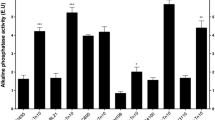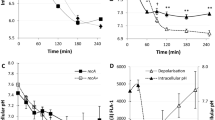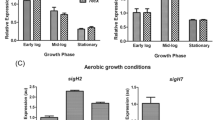Abstract
UV-inducible sulAp expression, an indicator of the SOS response, is reduced by recF + overexpression in vivo. Different DNA-damaging agents and amounts of RecO and RecR were tested for their effects on this phenotype. It was found that recF + overexpression reduced sulAp expression after DNA damage by mitomycin C or nalidixic acid. recO + and recR + overexpression partially suppressed the reduction of UV-induced sulAp expression caused by recF + overexpression. The requirement for ATP binding to RecF to produce the phenotype was tested by genetically altering the putative phosphate binding cleft of recF in a way that should prevent the mutant recF protein from binding ATP that should prevent the mutant recF protein from binding ATP. It was found that a change of lysine to glutamine at codon 36 results in a mutant recF protein (RecF4115) that is unable to reduce UV-inducible sulAp expression when overproduced. It is inferred from these results that recF overexpression may reduce UV-inducible sulAp expression by a mechanism that is sensitive to the ability of RecF to bind ATP and to the levels of RecO and RecR (RecOR) in the cell, but not to the type of DNA damage per se. Models are explored that can explain how recF + overexpression reduces UV induction of sulAp and how RecOR overproduction might suppress this phenotype.
Similar content being viewed by others
References
Bachmann BJ (1972) Pedigrees of some mutant strains of Escherichia coli K-12. Bacteriol Rev 36:525–557
Chaudhury AM, Smith GR (1985) Role of Escherichia coli RecBC enzyme in SOS induction. Mol Gen Genet 201:525–528
Ciesla Z, O'Brian P, Clark AJ (1987) Genetic analysis of UV mutagenesis of the Escherichia coli glyU gene. Mol Gen Genet 207:1–8
Clark AJ (1991) rec genes and homologous recombination on Escherichia coli. Biochimie 73:523–532
Clark AJ, Sandler SJ (1994) Homologous genetic recombination. Crit Rev Microbiol 20:125–142
Cohen A, Laban A (1983) Plasmidic recombination in Escherichia coli K12: the role of recF gene function. Mol Gen Genet 189:471–474
DiCapua E, Cuillel M, Hewat E, Schnarr M, Timmins PA, Ruigrok RWH (1992) Activation of RecA protein: the open helix model for LexA cleavage. J Mol Biol 226:707–716
Griffin TJ, Kolodner RD (1990) Purification and preliminary characterization of the Escherichia coli K-12 RecF protein. J Bacteriol 172:6291–6299
Hedge S, Sandler SJ, Clark AJ, Madiraju MVVS (1994) recO and recR mutations delay induction of SOS response in Escherichia coli. Mol Gen Genet (submitted)
Horii Z-I, Clark AJ (1973) Genetic analysis of the RecF pathway to genetic recombination in Escherichia coli K-12: isolation and characterization of mutants. J Mol Biol 80:327–344
Kolodner R, Fishel RA, Howard M (1985) Genetic recombination of bacterial plasmid DNA: effect of RecF pathway mutations on plasmid recombination in Escherichia coli. J Bacteriol 163:1060–1066
Korangy F, Julin DA (1992a) Alteration by site-directed mutagenesis of the conserved lysine residue in the ATP-binding consensus sequence of the RecD subunit of the Escherichia coli RecBCD enzyme. J Biol Chem 267:1727–1732
Korangy F, Julin DA (1992b) Enzymatic effects of a lysine to glutamine mutation in the ATP-binding consensus sequence in the RecD subunit of the RecBCD enzyme from Escherichia coli. J Biol Chem 267:1733–1740
Kushner SR, Nagaishi H, Templin A, Clark AJ (1971) Genetic recombination in Escherichia coli: the role of exonuclease I. Proc Natl Acad Sci USA 67:824–827
Lloyd RG, Sharples GJ (1992) Genetic analysis of recombination in prokaryotes. Curr. Opinion Genet Dev 2:683–690
Lloyd RG, Evans NP, Buckman C (1987) Formation of recombinant lacZ + DNA in conjugational crosses with a recB mutant of Escherichia coli K12 depends on recF, recJ, and recO. Mol Gen Genet 209:135–141
Madiraju MVVS, Clark AJ (1991) Effect of RecF protein on reactions catalyzed by RecA protein. Nucleic Acids Res 19:6295–6300
Madiraju MVVS, Clark AJ (1992) Evidence for ATP binding and double-stranded DNA binding by Escherichia coli RecF protein. J Bacteriol 174:7705–7710
Madiraju MVVS, Lavery PE, Kowalczykowski SC, Clark AJ (1992) The enzymatic properties of recA803 protein, the gene product encoded by a partial suppressor of recF mutations. Biochemistry 31:10529–10535
Mahajan SK (1989) Pathways of homologous recombination in Escherichia coli. In: Kucherlapati R, Smith GR (eds) Genetic recombination. American Society for Microbiology, Washington, DC, pp 87–140
McPartland A, Green L, Echols H (1980) Control of recA gene mRNA in E. coli: regulatory and signal genes. Cell 20:731–737
Peterson KR, Ossanna N, Thiveris AT, Ennis DG, Mount DW (1988) Derepression of specific genes promotes DNA repair and mutagenesis in Escherichia coli. J Bacteriol 170:1–4
Rehrauer WM, Kowalczykowski SC (1993) Alteration of the nucleotide triphosphate (NTP) catalytic domain with Escherichia coli recA protein attenuates NTP hydrolysis but not joint molecule formation. J Biol Chem 268:1292–1297
Sandler SJ, Clark AJ (1990) Factors affecting expression of the recF gene of E. coli K-12. Gene 86:35–43
Sandler SJ, Clark AJ (1993) Use of high and low level overexpression plasmids to test mutant alleles of the recF gene of E. coli K-12 for partial activity. Genetics 135:643–654
Sandler SJ, Clark AJ (1994) RecOR suppression of recF mutant phenotypes in E. coli K-12. J Bacteriol 176:3661–3672
Sandler SJ, Chackerian B, Li JT, Clark AJ (1992) Sequence and complementation analysis of recF genes from Escherichia coli, Salmonella typhimurium, Pseudomonas putida and Bacillus subtilis: evidence for an essential nucleotide binding fold. Nucleic Acids Res 20:839–845
Sassanfar M, Roberts J (1991) Constitutive and UV-mediated activation of RecA protein: combined effects of recA441 and recF143 mutations and of addition of nucleotides and adenine. J Bacteriol 173:5869–5875
Sassanfar M, Roberts JW (1990) Nature of the SOS-inducing signal in Escherichia coli: the involvement of DNA replication. J Mol Biol 212:79–96
Sung P, Higgins D, Prakash L, Prakash S (1988) Mutation of lysine-48 to arginine in the yeast RAD3 protein abolishes its ATPase and helicase activities but not the ability to bind ATP. EMBO J 7:3263–3269
Takiff HE, Baker T, Copeland T, Chen S-M, Court DL (1992) Locating essential Escherichia coli genes by using mini-Tn10 transposons: the pdxJ operon. J Bacteriol 174:1544–1553
Twigg AJ, Sherratt D (1980) Trans-complementable copy-number mutants of plasmid ColE1. Nature 283:216–218
Umezu K, Chi N-W, Kolodner RD (1993) Biochemical interaction of the Escherichia coli RecF, RecO and RecR proteins with RecA and single-stranded DNA binding protein. Proc Natl Acad Sci USA 90:3875–3879
Vieira J, Messing J (1982) The pUC plasmids, an M13mp7-derived system for insertion mutagenesis and sequencing with synthetic universal primers. Gene 19:259–268
Walker G (1987) The SOS response of Escherichia coli. In: Neidhardt FC et al. (eds) Escherichia coli and Salmonella typhimurium. American Society for Microbiology, Washington, DC, pp 1346–1357
Walker JE, Saraste M, Runswick MJ, Gay NJ (1982) Distantly related sequences in the α and β subunits of the ATP synthase, myosin, kinases and other ATP-requiring enzymes and a common nucleotide binding fold. EMBO J 1:945–951
Wang T-CV, Chang H-Y, Hung J-L (1993) Cosuppression of recF, recR and recO mutations by mutant recA alleles in Escherichia coli cells. Mutat Res 294:157–166
Willetts NS, Clark AJ, Low B (1969) Genetic location of certain mutations conferring recombination deficiency in Escherichia coli. J Bacteriol 97:244–249
Author information
Authors and Affiliations
Additional information
Communicated by R. Devoret
Rights and permissions
About this article
Cite this article
Sandler, S.J. Studies on the mechanism of reduction of W-inducible sulAp expression by recF overexpression in Escherichia coli K-12. Molec. Gen. Genet. 245, 741–749 (1994). https://doi.org/10.1007/BF00297281
Received:
Accepted:
Issue Date:
DOI: https://doi.org/10.1007/BF00297281




